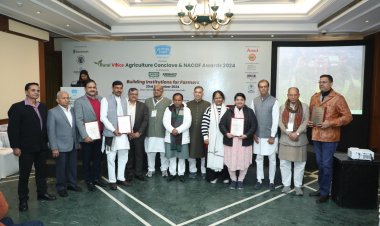Unprecedented intense rain hits crops
The India Meteorological Department (IMD) has advised farmers in around a dozen states and Union Territories to drain out excess water from their fields so that standing crops are saved from rotting. It has asked farmers to postpone sowing or transplanting of paddy and sowing of other Kharif crops like maize and pulses. The damage to the moong, urad, groundnut and soybean crops could range 10-15%, leading to concerns about a significant increase in prices of these commodities.

It's a double blow for Kharif crops across India. First it was a delayed southwest monsoon that had impacted Kharif crops with low soil moisture. Then came a record-breaking, heavy to extremely heavy rainfall in different regions, especially in the northwestern states of Himachal Pradesh, Uttarakhand, Punjab, Haryana and Uttar Pradesh, that dealt a crushing blow by inundating the fields of already sown crops.
The India Meteorological Department (IMD) has advised farmers in around a dozen states and Union Territories to drain out excess water from their fields so that standing crops are saved from rotting. It has asked farmers to postpone sowing or transplanting of paddy and sowing of other Kharif crops like maize and pulses. The damage to the moong, urad, groundnut and soybean crops could range 10-15%, leading to concerns about a significant increase in prices of these commodities.
While Punjab and Haryana have also witnessed excessive rainfall in the last few days - falling in IMD's category of "large excess" - it could help the paddy crop which requires standing water. Maize and cotton crops seem to have been affected the most, with farmers staring at heavy losses.
The National Agromet Advisory Services Bulletin issued on July 10, 2023, by the Indian Council of Agricultural Research (ICAR) and IMD asked farmers to remove excess water from maize fields, “as maize is very sensitive to standing water”. This precautionary measure is crucial as standing water can have a detrimental impact on the crops, which can lead to stalk rot.” The crop sowing acreage in the Kharif season has been less than last year, showed government data. Sowing of all kharif crops, including paddy, decreased in the first week of July.
By July 2023, 35.34 million hectares (mha) had been sown, showed data from the National Food Security Mission website of the Union Ministry of Agriculture and Farmers Welfare. This is 3.36 mha (8.68 per cent) less than last year and 9.48 mha or 22 per cent less compared to 2021. Rice is the main crop of the Kharif season. Statistics showed that paddy sowing may be significantly impacted this year. Paddy is sown between June 15 and July 15 in most rice-producing states of the country. This period will elapse in seven days.
According to the figures, 23.89 per cent of the area was not sown by July 7, compared to the same period last year. Paddy has been sown in 5.41 mha until the first week of July this year. Last year, paddy had already been sown in 7.11 mha by the first week of July. Meaning, paddy has not been sown in 1.7 mha this time. The crop damage due to heavy rainfall in the last two days will be another blow to the sowing activities, thus impacting the food production in the country.
Meanwhile, since July 4, the IMD has been issuing advisories to postpone sowing in different states. From July 4-8, it has advised the farmers not to go for nursery sowing of Kharif rice in sub-Himalayan West Bengal, Sali rice in Meghalaya and sowing of direct seeded rice in coastal Karnataka, postponing transplanting of rice in Kerala, coastal Karnataka, south Konkan and Goa.
On July 9, the IMD added Jammu and Kashmir, Uttarakhand and Himachal Pradesh in the list of states it advised to postpone transplanting of rice and sowing of maize, Kharif pulses, vegetables and soybean in these states, given the heavy rainfall situation in the last two days in these states.
In the northwest, while Rajasthan has received nearly 60% more rains than the long period average till July 10, Gujarat received 15% more, according to the IMD. This was contrary to its initial predictions. With Cyclone Biparjoy bringing rains to Gujarat and Rajasthan in early June, sowing for the kharif season had started early, but the recent heavy rainfall could have damaged the plants which were in the germination stage.
The incessant rains in several northern states have led the IMD to issue advisory for farmers in Himachal Pradesh, Uttarakhand, Punjab, Haryana, Uttar Pradesh and Rajasthan. It has asked farmers to postpone transplanting of rice in Jammu & Kashmir, Himachal Pradesh & Uttarakhand. It has also requested farmers to postpone sowing of maize, kharif pulses, soybean and vegetables in Jammu & Kashmir and Uttarakhand.
In its latest forecast, the IMD has predicted widespread rainfall to continue over Gujarat, and heavy to very heavy rainfall in Rajasthan. It has also predicted extremely heavy rainfall activity over Northeast India and adjoining East India in the next three days. Meghalaya, Arunachal Pradesh, Sub-Himalayan Sikkim and West Bengal are expected to get extremely heavy rainfall till July 12. It has issued an orange alert for parts of Arunachal Pradesh and Sikkim till July 12.
The onset of the southwest monsoon over Kerala happened on June 8, 2023, a week later than its normal onset date of June 1. Monsoon 2023 has almost covered the entire country by June 30 - about a fortnight earlier than usual of July 15. Last year, the monsoon had arrived early - the India Meteorological Department (IMD) had declared the onset on May 29, 2022. However, the monsoon had arrived on June 8 in 2019 and 2016 as well.



 Join the RuralVoice whatsapp group
Join the RuralVoice whatsapp group






































